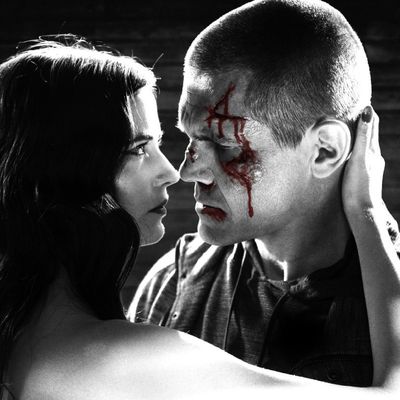
In Sin City: A Dame to Kill For, schlock director Robert Rodriguez and dark-souled graphic artist Frank Miller indulge in the crudest kind of nihilism, but they sure create some purty pictures. This movie, in black-and-white with judicious daubs of color, is the highest-gloss revenge porn imaginable. It’s hard to believe that so much visual elegance has been brought to bear on material so ugly, and yet the disjunction is intentional, and the film is all of a piece. Knowing that everyone will go rotten is meant to free you up to enjoy the spectacle of pinwheeling dismembered bodies and blood that splashes like an Abstract Expressionist’s oil paint. It’s one big, beautiful shit canvas.
As in the first Sin City (2005), Rodriguez and Miller fashion everything from scratch, but the actors, who are set down in noirer-than-noir frames. Each of the three story lines is like Film Noir for Dummies. Some characters return, most happily Mickey Rourke as the galoot Marv, an ecstatic pummeler of faces and splitter of skulls — nothing brings him to life like the bringing of death. Marv isn’t central to any of the stories, but he’s in and out of the action, and his easygoing cynical narration makes us feel warm and good inside. Staring at Marv’s puttyish, acromegaly-like visage means we don’t have to stare at the puffer-fish mess that is Rourke’s, and the actor’s titanic, self-destructive spirit fills up the monster mask and then some. He’s not as startling as he was in the first Sin City, but he gives the film its black heart.
The movie itself isn’t as startling, either, but the first half, at least, is very inventive, and there’s one good new face: Joseph Gordon-Levitt as Johnny, a supernaturally adept gambler who arrives in Sin City (a stand-in for Los Angeles) to go up against senator and sadistic crime boss Roark (Powers Boothe). There’s a fabulous image of Roark behind piles of poker chips that look like skyscrapers, and Gordon-Levitt’s open, not-quite-grown-up face gives the film a touch of romance. Early on, Johnny picks up a moll named Marcie (Julia Garner), who’s the only colored-in character: sunrise-orange hair, skin with the pink of a white peach. Johnny and Marcie are the movie’s ingénues, and you know — the characters constantly tell us, in narration — that nothing innocent can withstand this corrosive milieu.
The other new protagonist is Dwight (Josh Brolin), an unofficial private dick (he snaps compromising photos) with the hulking demeanor of an ape and a fear of losing control and “letting the monster out.” This proves unusually difficult, given his erotic addiction to Ava (Eva Green), the killer dame who gives the film its title and, in one va-va-voom scene, emerges radiantly naked from a pool with a giant full moon behind her. Color comes and goes with Ava’s power: now her lips are ruby-red, now her eyes a demon-green. Married to a rich and allegedly abusive man, she is trailed wherever she goes by a giant chauffeur (Dennis Haysbert), and the question hangs whether she’s his prisoner or mistress, a damsel in distress or a deadly dominatrix. Actually — given the setting — it’s not much of a question.
Last and least of the protagonists is the stripper Nancy (Jessica Alba), whose savior, a cop named Hartigan (Bruce Willis), didn’t survive the first Sin City. He’s back, though, making this the second time that Willis has played a ghost. But this one is a dull fellow. Does Willis have to be so obvious when he’s in it for the paycheck? He stands there looking sad and that’s all, and Alba doesn’t have the acting chops to carry their scenes. Nancy is supposed to be disintegrating before our eyes, but there are no stages in her descent — she’s the same (a drag) at the end as is at the beginning. When she points a gun at Roark, Boothe responds with the fakest Evil Laugh since John Travolta’s dreadlocked “Psychlo” in Battlefield Earth. It almost saves the scene.
I could go on about the cast (which includes Christopher Meloni and Jeremy Piven as cops; Lady Gaga as a waitress; Rosario Dawson as the leader of the gartered Amazonions of Old Town, where “the girls” have laws of their own; and Jamie Chung as the requisite Asian killing-dervish), but Sin City 2 is all about the Look. Since Rodriguez’s movies are eyesores, you have to assume the compositional wit is Miller’s — the webs of shattered glass, the whited-out whirlybirds and trees and telephone lines, the charcoal-sketch immediacy of nearly every image. When color does appear, it can make you laugh out loud. Tail lights glow red, a fat cigar puts out a sudden — almost subliminal — shower of orange embers, and Haysbert sports a glowing golden orb in one eye after the original has been violently plucked. Abrasions show up as ragged bits of red on characters’ faces, but as various baddies are slashed and decapitated, the blood splatters brilliantly white. What Rodriguez brings is a lickety-split tempo. None of the frames carry the excess of awe that made the film of Watchmen a lead balloon. This really is a graphic novel brought to life.
But Rodriguez and Miller’s definition of life is a colossal bore: “Death is just life in Sin City …,” one character intones, and a universe so inevitably malignant can be just as insipid as a happy-time one. Apart from one character’s shocking death, the casualness of the carnage makes Sin City 2: A Dame Dame to Kill For weightless. To paraphrase an old TV show, there are a million stories in Sin City, but they’re all the damn same.


